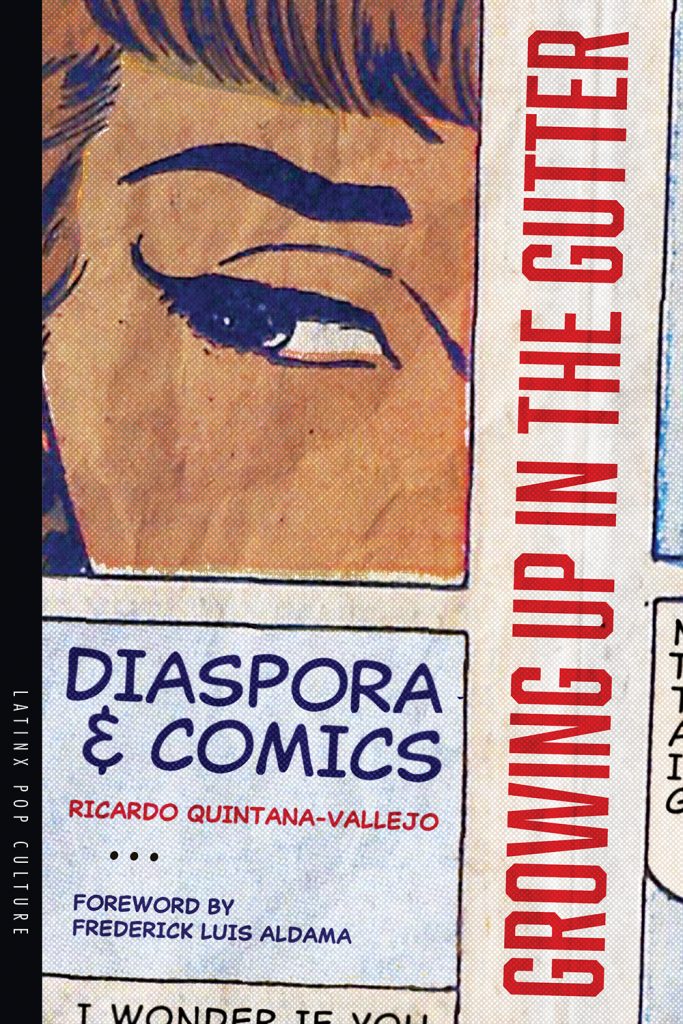Growing Up in the Gutter
Diaspora and Comics
Paperback ($26.95), Ebook ($26.95)
Buy
Growing Up in the Gutter offers new understandings of contemporary graphic coming-of-age narratives by looking at the genre’s growth in stories by and for young BIPOC, LGBTQ+, and diasporic readers. Through a careful examination of the genre, Ricardo Quintana-Vallejo analyzes the complex identity formation of first- and subsequent-generation migrant protagonists in globalized rural and urban environments and dissects the implications that these diasporic formative processes have for a growing and popular genre.
While the most traditional iteration of the bildungsroman—the coming-of-age story—follows middle-class male heroes who forge their identities in a process of complex introspection, contemporary graphic coming-of-age narratives represent formative processes that fit into, resist, or even disregard narratives of socialization under capitalism, of citizenship, and of nationhood.
Quintana-Vallejo delves into several important themes: how the coming-of-age genre can be used to study adulthood, how displacement and international or global heritage are fundamental experiences, how multidiasporic approaches foreground lived experiences, and how queerness opens narratives of development to the study of adulthood as fundamentally diverse and nonconforming to social norms. Quintana-Vallejo shows how openness enables belonging among chosen families and, perhaps most importantly, freedom to disidentify. And, finally, how contemporary authors writing for the instruction of BIPOC children (and children otherwise affected by diaspora and displacement) use the didactic power of the coming-of-age genre, combined with the hybrid language of graphic narratives, to teach difficult topics in accessible ways.
While the most traditional iteration of the bildungsroman—the coming-of-age story—follows middle-class male heroes who forge their identities in a process of complex introspection, contemporary graphic coming-of-age narratives represent formative processes that fit into, resist, or even disregard narratives of socialization under capitalism, of citizenship, and of nationhood.
Quintana-Vallejo delves into several important themes: how the coming-of-age genre can be used to study adulthood, how displacement and international or global heritage are fundamental experiences, how multidiasporic approaches foreground lived experiences, and how queerness opens narratives of development to the study of adulthood as fundamentally diverse and nonconforming to social norms. Quintana-Vallejo shows how openness enables belonging among chosen families and, perhaps most importantly, freedom to disidentify. And, finally, how contemporary authors writing for the instruction of BIPOC children (and children otherwise affected by diaspora and displacement) use the didactic power of the coming-of-age genre, combined with the hybrid language of graphic narratives, to teach difficult topics in accessible ways.
“This is a wonderful book about comics, coming-of-age, and racialized identities as they intersect with other aspects of identity such as poverty, refugee status, or LGBTQIA2S+ identities. The author examines how difference enriches and complicates the coming-of-age narrative and how complex the journey to adulthood can be through an examination of a richly diverse group of YA comics.”—Marni Stanley, Vancouver Island University
"Graphic novelists express themselves through textual and visual layout when crafting their narratives, and the gutter is one of the most important tools. Quintana-Vallejo describes gutters in comics as 'the wholly significant white space between panels,' a metaphor that cautions readers not to gloss over topics such as gender, race, class, legal status, and sexuality when engaging with coming-of-age graphic novels.”—R. M. Roberts, CHOICE Connect
"Graphic novelists express themselves through textual and visual layout when crafting their narratives, and the gutter is one of the most important tools. Quintana-Vallejo describes gutters in comics as 'the wholly significant white space between panels,' a metaphor that cautions readers not to gloss over topics such as gender, race, class, legal status, and sexuality when engaging with coming-of-age graphic novels.”—R. M. Roberts, CHOICE Connect
 The University of Arizona Press
The University of Arizona Press

